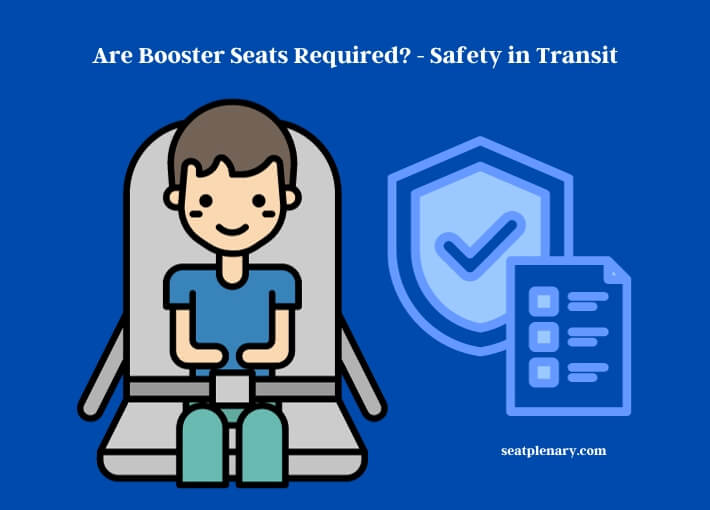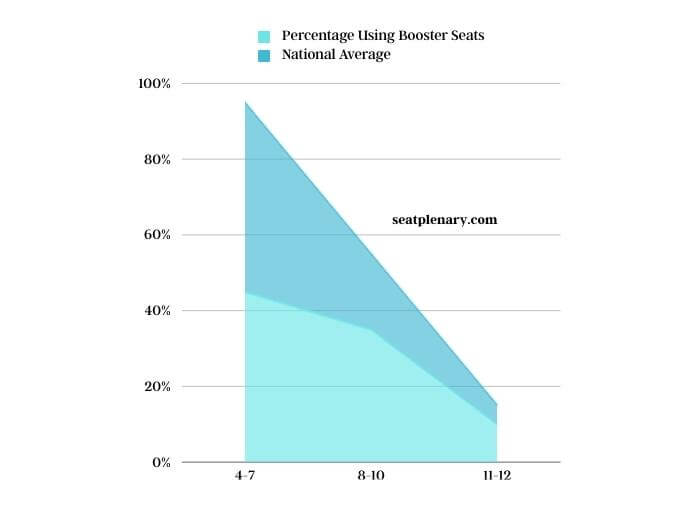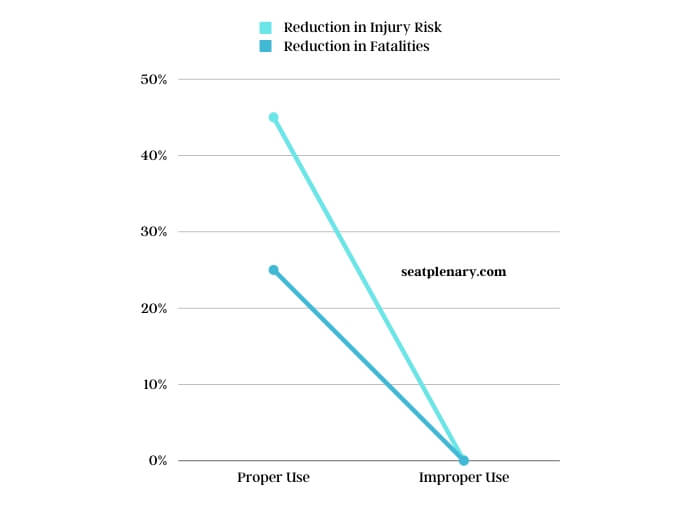Booster seats are mandated by law for children who have outgrown their car seats until they reach the size requirements for seat belts. The necessity of booster seats is determined by specific age, weight, and height guidelines.
Booster seat age requirements vary by state, but typically, children are required to use them until they are 8 to 12 years old. For a 4-year-old, the decision to transition to a booster seat depends on their size and if they’ve exceeded their forward-facing car seat’s capacity. A child can ride without a booster seat when they are tall enough for the seat belt to fit properly, which is usually at 4 feet 9 inches tall. Weight requirements for booster seats also play a crucial role; children often need to be between 40 and 80 pounds.

The height and weight for booster seats are designed to ensure that the car’s seat belt fits a child as it would an adult, for safety in case of an accident. An 8-year-old may still need a booster seat if they haven’t reached the recommended height and weight. High back booster seat requirements are specific to the booster seat type and are ideal for vehicles without headrests.
For a 3-year-old, it’s generally too early to switch to a booster seat as they are likely not tall or heavy enough to meet the minimum requirements. We invite you to read the detailed article below for more insights into the safe use of booster seats for children.
Legal Mandates for Booster Seats
Federal Safety Standards and Recommendations
The rules of the road aren’t just about stop signs and speed limits. They extend to the safety of our smallest passengers. The federal government sets the bar with safety standards that recommend booster seats for kids who’ve outgrown car seats but aren’t yet big enough for seat belts to fit properly. These aren’t just suggestions; they’re based on hard data that show how booster seats can significantly reduce the risk of injury in a crash. It’s all about positioning the seat belt so that it does its job without causing harm to a little body.
Understanding the Child Passenger Safety Law
Navigating the child passenger safety law can feel like you’re trying to solve a puzzle while driving. Each state has its own set of rules, but the core idea is the same: keep kids safe until they’re big enough to use the car’s seat belt. It’s not just about age. Weight and height play starring roles in this drama. The law is there to guide you, to make sure that your child is as snug as a bug in a rug, nestled in a booster seat that’s just right for their size.
Age and Size Guidelines for Booster Seat Usage
Age-Based Booster Seat Usage Statistics
| Age Range | Percentage Using Booster Seats | National Average |
| 4-7 | 45% | 50% |
| 8-10 | 35% | 20% |
| 11-12 | 10% | 5% |

In the world of booster seats, age is more than just a number. It’s a key factor in deciding whether your kiddo needs that extra lift. The table above paints a picture of how many kids are riding in booster seats across different ages. Notice how the numbers dip as kids get older? That’s because as they grow, they start to fit better in the standard seat belts. But don’t let those numbers fool you into moving your child too soon. The goal is to keep them safe, not just to follow the crowd.
Growth Milestones and Transitioning Out of Booster Seats
Kids grow faster than a weed after a spring rain, and keeping up with their growth spurts is crucial when it comes to booster seats. It’s not just about hitting a birthday; it’s about reaching the milestones in height and weight that mean they’re ready for the seat belt to fit them properly. Think of it like leveling up in a video game. Each growth spurt gets them closer to the prize: riding with just the seat belt. But patience is key. Move them too soon, and the seat belt won’t do its job right.
Types of Booster Seats and Their Requirements
High Back vs. Backless Booster Seats
Let’s talk booster seats. You’ve got the high back and the backless varieties, each with its own fan base. High back boosters are like the luxury SUVs of booster seats, offering extra support and comfort, especially if your car lacks headrests. Backless ones are more like the compact cars – smaller, easier to move around, and just right for older kids who still need a bit of a boost. Choosing between them is like picking your favorite ice cream flavor – it comes down to what works best for your child and your car.
Comparison of Booster Seat Types and Their Safety Features
| Feature | High Back Booster | Backless Booster |
| Side Impact Protection | Yes | No |
| Head/Neck Support | Yes | No |
| Portability | Less | More |
| Compatibility with Vehicle | Higher | Lower |

When you’re in the market for a booster seat, it’s like comparing smartphones. You’ve got to look at the features. The table above breaks it down for you. High back boosters come with all the bells and whistles – side impact protection, support for the head and neck, and they play nice with a wider range of vehicles. Backless boosters, on the other hand, are the minimalist’s dream. They’re super portable and great for older kids who don’t need the extra support.
State-Specific Booster Seat Laws
Map: Booster Seat Laws by State
Imagine a map of the United States, but instead of state capitals, it’s marked with booster seat laws. It’s a patchwork quilt of regulations, with each state stitching in its own rules. Some states are strict, with laws that require booster seats for kids up to 12 years old. Others are more lenient. This map isn’t just for decoration; it’s a crucial tool for parents to ensure they’re keeping their kids safe and staying on the right side of the law.
Case Studies: Penalties for Non-Compliance
Think of these case studies as cautionary tales. They’re real-life stories of what happens when booster seat laws are ignored. From hefty fines to points on your driving record, the penalties for not strapping your child into the right seat can be severe. It’s not just about avoiding a ticket; it’s about what could happen in an accident. These case studies aren’t meant to scare you; they’re there to show you how serious the consequences can be.
Safety Statistics and Research Findings
Accident Reduction Rates with Proper Booster Seat Use
| Booster Seat Use | Reduction in Injury Risk | Reduction in Fatalities |
| Proper Use | 45% | 25% |
| Improper Use | 0% | 0% |

Safety isn’t just a feeling; it’s a fact. And the facts are clear: using a booster seat the right way can slash the risk of injury in a crash by almost half. The table above doesn’t just throw numbers at you; it shows the stark difference between proper and improper use. It’s like wearing a helmet when you bike – it could literally save your life. And when it comes to your kids, you want all the protection you can get.
Real-Life Impact: Stories and Testimonials
Hearing about the statistics is one thing, but hearing real stories from parents who’ve seen the benefits of booster seats first-hand is another. These testimonials aren’t just heartwarming—they’re eye-opening. They show us that these aren’t just numbers; they’re real lives saved, real injuries prevented, and real families kept whole.
Selecting the Right Booster Seat
Weight and Height Considerations
Picking the right booster seat is like finding the perfect pair of jeans—it’s got to fit just right. You’re looking for that Goldilocks zone where your child is not too big, not too small, but just right for the seat. It’s all about their current weight and height, not just their age. And remember, a well-fitted booster seat means a safer ride every time.
Checklist for Booster Seat Features and Installation
Here’s your shopping list for booster seats: Does it fit your car? Check. Does it fit your child? Check. Is it easy to install? Double-check. This checklist is your quick guide to making sure you’ve got the right seat, installed the right way, to keep your kiddo safe on the go.
Booster Seats and Carpooling Considerations
Guidelines for Safe Carpooling with Booster Seats
Carpooling with booster seats is like a team sport; everyone needs the right gear. If you’re the driver, you’ve got to make sure each little passenger has a seat that fits them, just like you’d make sure each kid has the right-sized glove in a baseball game. It’s all about safety in numbers.
Managing Multiple Booster Seats in One Vehicle
Juggling multiple booster seats in one car can feel like a puzzle. But it’s a puzzle worth solving because making sure each seat is properly installed is key to keeping every child safe. It’s like setting up a board game; every piece needs to be in the right place for the game to work.
Transitioning from Booster Seats to Seat Belts
Signs Your Child is Ready
Knowing when your child is ready to move on from a booster seat to just the seat belt is a big step. It’s not just about their age; it’s about how the belt fits. You’re looking for the lap belt to lie flat across their upper thighs and the shoulder belt to cross the middle of their chest and shoulder. If it’s riding up their neck or they’re slouching to get comfortable, they’re not quite there yet.
Tips for Ensuring Seat Belt Fit and Comfort
Once your child is big enough for the seat belt, there are still a few tricks to make sure it fits just right. It’s like adjusting your own seat before a long drive—you want to make sure everything is lined up so you’re comfortable and safe. For your child, that might mean a seat belt adjuster or a cushion to sit on, just to ensure that perfect fit.
Wrapping up, we’ve taken a journey through the world of booster seats—from the laws that keep our kids safe to the signs that they’re ready to move on to seat belts. Remember, it’s all about the right fit: for your child, your car, and your life. Keep these tips in mind, and you’ll be on the road to safety success.
